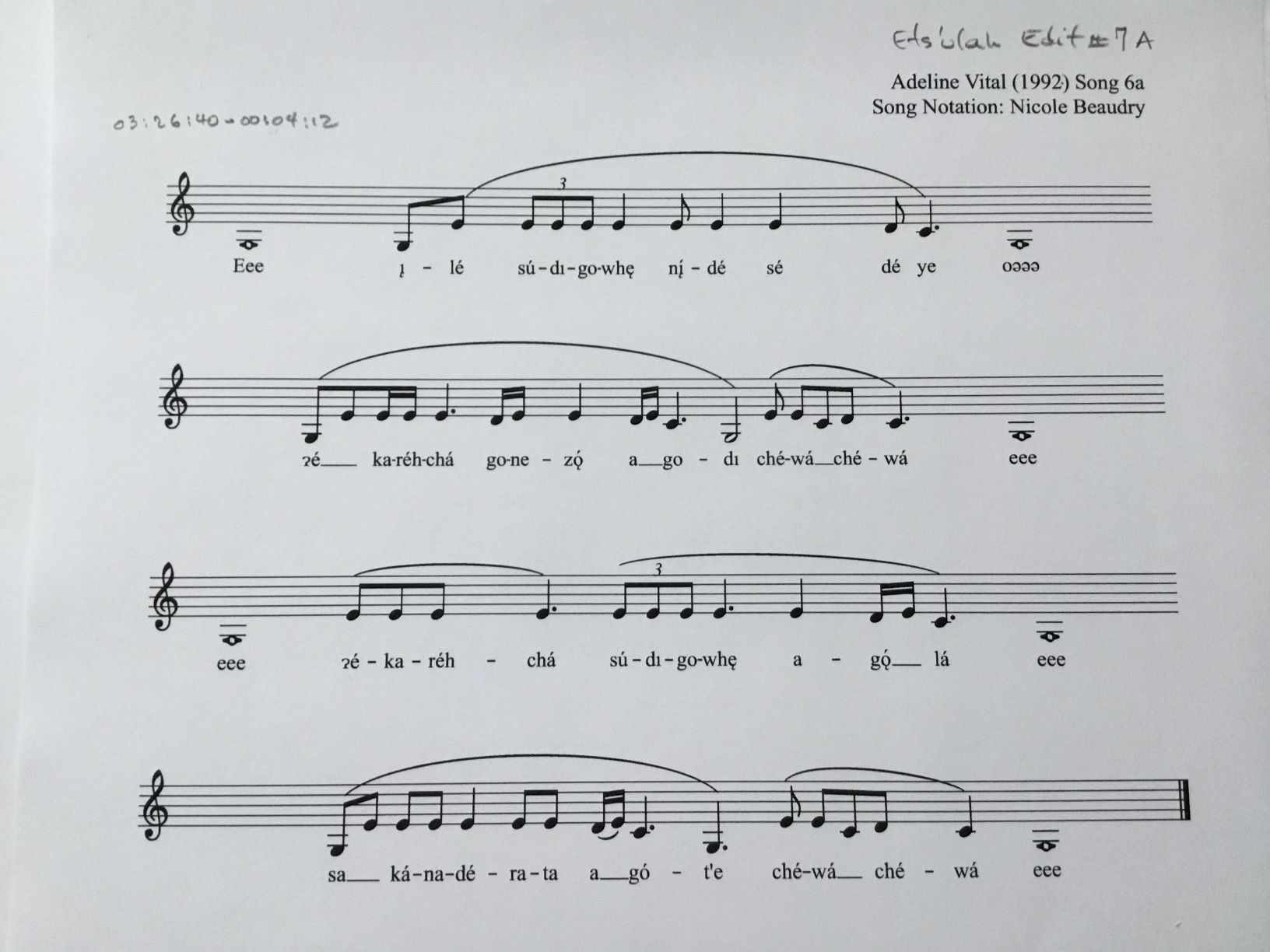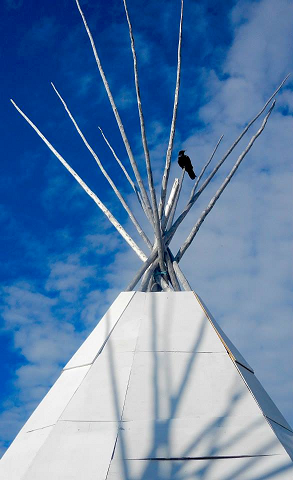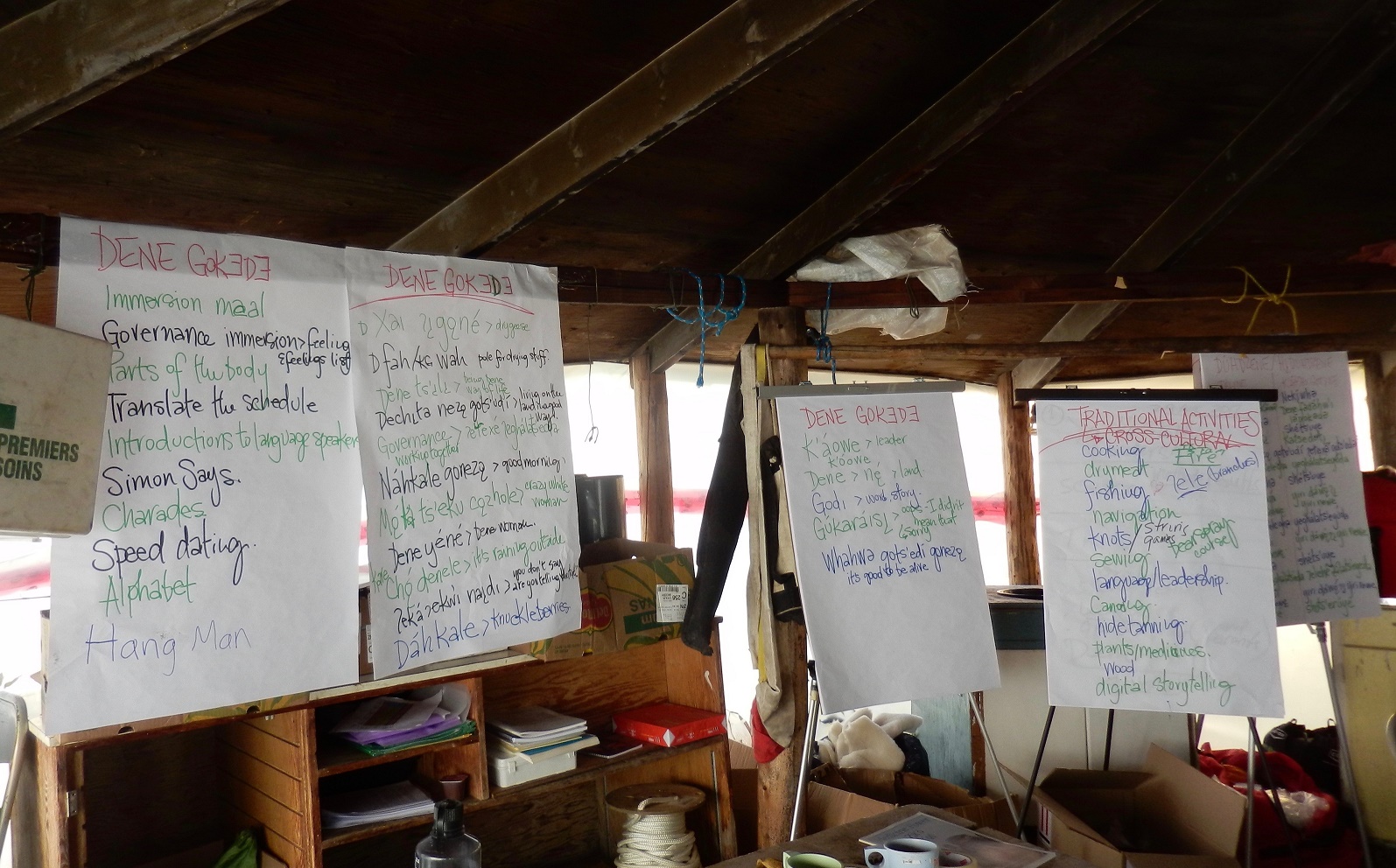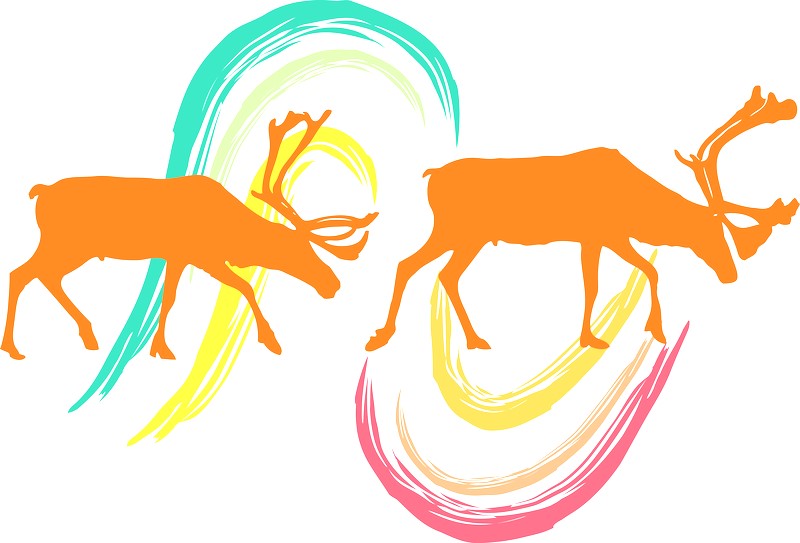2014-2018 Délı̨nę Song Book
The Délı̨nę Song book is about the singing, drumming, and playing traditions of the Sahtúot'ine who nowadays live in Délı̨nę, a community on the shore of Sahtú (Great Bear Lake) in the Canadian Northwest Territories. There are many reasons such a book can be of interest, but the main objective here is to offer to the people of Délı̨nę one path into their historical past, the song path. The materials brought together here come mainly from a recording collection I made between 1988 and 1992 (also in 2012, 2014, and 2015) with many Elders who not only talked to me, but also sang a good number of songs. Thus this book-with-audio should reflect those Elders' talking and singing voices, and much of the knowledge and wisdom they wished to transmit to the future generations. Already in 1988, many of them told me that they thought these recordings were useful for exactly that purpose. They are still saying it today.
For example Alfred Taniton who was talking one day about the old Dene ways of playing finished his explanation by saying what he thought of this book-with-audio project:
"Now it's not like that, so our games from long time ago, and all that Elders did on the land, we don't talk to them about it now. At school they do what they have to do, so now our children start to think differently. But if we make a good book for them, and they see it, they will agree. They will think: "That's why we had Elders with us." So when she's asking questions about this, she is doing the right thing. Whatever we know, we should tell her. It must be good." (Alfred Taniton 2015 ACQ 3345-0061)
The idea was to give back to Délı̨nę the benefits of a research project that started so long ago in a way that would be immediately useful. So, from the many hours of recording featuring 19 Délı̨nę Elders, some 125 audio excerpts were chosen to illustrate the different topics: ets'ulah, ı́lıwáh, edzi, náogeye, ǝghǝle, naowhenáreɂę, godı, and a few other things such as a discussion of Dene singing styles. Each topic presented will be accompanied by a specific Dene-English terminology. Approximately 100 audio excerpts were transcribed into Dene by Alina Takazo, including song texts when possible. Also translated into English, the texts are complemented with song notations (approx 150). Some drawings by Dennis Kenny as well as a number of photographs will also be included.

WHY WRITE A BOOK ABOUT SONGS? Why not just hear the songs themselves on an audio document? Because I strongly believe that songs are a powerful vehicle for any people's traditions, although their meaning is not always obvious at first hearing, even for those of the same culture. Most Dene singers tell the story of their song, and explain how it is meaningful to them. It is so important that young people hear their elders' words about the songs and the traditional Dene lifestyle. That is why the book is called SONGS and STORIES from Délı̨nę. Together, these songs and stories open the door to Délı̨nę's historical past, to the profound human values inherent to Dene culture, to the relationships and behaviours of groups and individuals, to people's spiritual lives, to their sense of humour, and to their capacity for rejoicing. Yes, all of that can be learned through song. But more importantly even, the songs enhance the importance of learning to 'listen' (as opposed to simply hearing) - not only with one's ears, but also with one's heart and intelligence. Listening leads to learning, which means that one is in possession of necessary tools for a long and harmonious life.
Team Members
Author
Core Team
Délı̨nę Elders
- Marı́zó (Julia Baptiste)
- Lúza (Louisa Baton)
- Chı̨ą (Paul Baton)
- Laı́za (Eliza Blondin)
- Magırı́ (Margaret Kenny)
- Behcho (George Kodakin)
- Béla (Bella Modeste)
- Cıcı́l (Cecile Modeste)
- Ǫ́ɂk'aeh (Leon Modeste)
- Tehk'áotah (Joe Naedzo)
- Cháhlıht'ǫ́ą (Charlie Neyelle)
- Jenéo or enǫ́ǫ Jane (Jane Neyelle)
- Janı́ (John Neyelle)
- Ts'ǫ́gǫné (Jane Quitte)
- Wılém (William Sewi)
- Alıferé (Alfred Taniton)
- Lue (Louie Taniton)
- Ádelı̨́ (Adeline Vital)
- Doraghı̨́ą (Dora Vital)
Community Collaborators
- Albertine Baton
- Stella Baton-Modeste
- Walter Bayha
- Augustine Kenny
- Sarah Kodakin-Masazumi and Alfred Masazumi.
- Jane Modeste
- Fibbie Tatti
- Mary-Rose Yukon
Partners
- Prince of Wales Archives (who contributed audio technician Norman Glowach time)
- SRRB as administrator of project funds
Funders:
- 1988-1992, Social Sciences and Humanities Research in Canada (SSHRC)
- 2012-2014 Volkswagen Foundation
- 2014-2018 NWT Department of Education, Culture, and Employment (ECE)
Funding for the book project
2014-2018, from ECE, approximately $50,000.
2017-ongoing From Dene Kedǝ to Dene Ts’ı̨lı̨: Rethinking Resurgence in the Sahtú Region
 From Dene Kedǝ to Dene Ts’ı̨lı̨ is a collaborative project that explores lessons learned through the past fifty years of Dene and Métis language and way of life initiatives. Bringing together knowledge and experience from longtime activists and educators and youth, as well as review of over 275 documents, the aim is to create a resource for decision-makers and researchers as a basis for resurgence in the Sahtú Region. All phases of this project involve a dialogue between today’s initiatives and yesterday’s legacy.
From Dene Kedǝ to Dene Ts’ı̨lı̨ is a collaborative project that explores lessons learned through the past fifty years of Dene and Métis language and way of life initiatives. Bringing together knowledge and experience from longtime activists and educators and youth, as well as review of over 275 documents, the aim is to create a resource for decision-makers and researchers as a basis for resurgence in the Sahtú Region. All phases of this project involve a dialogue between today’s initiatives and yesterday’s legacy.
The picture that has emerged is complex, involving at least seven domains of resurgence: speakers and learners; local knowledge; documentation; education; media; law and policy; and ways of life. During this project we saw the emergence of exciting projects like the Dene Ts’ı̨lı̨ School, a cross-cultural on the land learning opportunity for youth. This school became an integral part of the research and learning process.
Explore the resources that contributed to this research using the Dene Kedǝ to Dene Ts'ı̨lı̨ Catalogue of Resources.
Key Messages
Three key messages have emerged so far from this project:
1. Sahtú Dene and Métis families need to live, learn and be well on the land.
2. Holistic Dene Kedǝ and Dene Ts'ı̨lı̨ programs support strong governance.
3. Youth need to be drivers for Dene Kedǝ and Dene Ts'ı̨lı̨ initiatives.
Phase One – Research and Reporting
January-October 2017, and ongoing
 The research team began with a SSHRC-funded research project, resulting in an October 2017 report. This report synthesized existing knowledge about Dene Kedǝ, (Dene language) and Dene Ts’ı̨lı̨ (being Dene, Dene ways of life) in the Sahtú Region. Its focus, was to review revitalization programming from the last 50 years of Sahtú history, in order to understand what work was already done, what impact it has had, and what lessons have been learned from it. Key report sections included a literature review; a synthesis of Dene and Métis youth interviews; a timeline; an annotated bibliography; key messages for policy; and a plan for knowledge mobilization. The research team recognizes that there remain gaps in the compilation, and plans to continue adding to the compilation during Phase 2.
The research team began with a SSHRC-funded research project, resulting in an October 2017 report. This report synthesized existing knowledge about Dene Kedǝ, (Dene language) and Dene Ts’ı̨lı̨ (being Dene, Dene ways of life) in the Sahtú Region. Its focus, was to review revitalization programming from the last 50 years of Sahtú history, in order to understand what work was already done, what impact it has had, and what lessons have been learned from it. Key report sections included a literature review; a synthesis of Dene and Métis youth interviews; a timeline; an annotated bibliography; key messages for policy; and a plan for knowledge mobilization. The research team recognizes that there remain gaps in the compilation, and plans to continue adding to the compilation during Phase 2.
Phase Two – Knowledge Mobilization
Ongoing
 The research team has begun building results into a searchable database, sharing results on social media, and adding new resources to accessible platforms as they are surveyed. Future goals include the development of an interactive online timeline. This review of historical programming also continues to inform contemporary projects with youth such as the Dene Ts’ı̨lı̨ School, which many of the Dene Kede to Dene Ts’ı̨lı̨ report co-authors are involved with. A further output of this project has been the development of a new network of knowledgeable individuals, both currently active and retired, as well as Territorial and regional organisations with an interest in supporting Dene Kedǝ and Dene Ts'ı̨lı̨ processes. As Sahtú-based co-authors directly apply research results in regional and community initiatives (such as the SRRB, Nę K’ǝ Dene Ts'ı̨lı̨ Forum, Sahtú Youth Network, and local Ɂehdzo Got'ı̨nę), the regional network will disseminate knowledge with an eye to best practices in policy and scholarship.
The research team has begun building results into a searchable database, sharing results on social media, and adding new resources to accessible platforms as they are surveyed. Future goals include the development of an interactive online timeline. This review of historical programming also continues to inform contemporary projects with youth such as the Dene Ts’ı̨lı̨ School, which many of the Dene Kede to Dene Ts’ı̨lı̨ report co-authors are involved with. A further output of this project has been the development of a new network of knowledgeable individuals, both currently active and retired, as well as Territorial and regional organisations with an interest in supporting Dene Kedǝ and Dene Ts'ı̨lı̨ processes. As Sahtú-based co-authors directly apply research results in regional and community initiatives (such as the SRRB, Nę K’ǝ Dene Ts'ı̨lı̨ Forum, Sahtú Youth Network, and local Ɂehdzo Got'ı̨nę), the regional network will disseminate knowledge with an eye to best practices in policy and scholarship.
Team Members
For more information about this project, or to access this project’s resources, please contact Deborah Simmons at This email address is being protected from spambots. You need JavaScript enabled to view it..
Sponsors
This research was supported by the Social Sciences and Humanities Research Council of Canada: An Indigenous Knowledge Synthesis Project as part of the Imagining Canada’s Future Initiative. The team also thanks the Ɂehdzo Got'ı̨nę Gots'ę́ Nákedı and University of Toronto for their partnership.
Total Budget
$50,000
Research Summary
pdf
Dene Kedǝ to Dene Ts'ı̨lı̨ - Máhsı cho, ToC and Executive Summary.(636 KB)
Report
This report provides an overview of the implications of this Knowledge Synthesis, followed by a discussion of project scope and approach. Results are provided in two sections: first a thematic timeline summarizing the literature review, and second a summary of key messages from the activities, focus groups and interviews at Dene Ts'ı̨lı̨ School. More details are provided in a series of appendices.
pdf
Full report with appendices.(4.03 MB)
Report Sections
pdf
Main report.(983 KB)
pdf
Appendix A(189 KB)
: a list of acronyms and terms used in the report, along with a map of Sahtú communities.
Food Security
Alison Blay-Palmer (Director, Laurier Centre for Sustainable Food Systems) and Andrew Spring (Ph.D. Candidate, Wilfred Laurier University) worked with the SRRB on the Best of Both Worlds project. Alison and Andrew both participated in planning meetings; in addition, Andrew attended a regional workshop in Deline in February 2014 and contributed a literature review to the project’s 2013-2014 report. Their work focuses on food security – the idea that all people at all times should have access to sufficient, safe, nutritious food to maintain a healthy and active life. 1 In the Sahtú, food security relates to both the SRRB’s wildlife management mandate and to the involvement of community members in the process of wildlife management.
The SRRB was invited to attend the Sustainable Regional Food Systems Workshop on June 25-27 at the Balsillie School for International Affairs, Waterloo, Ontario to deliver a presenation about the Best of Both Worlds project and participate in planning for a five-year, $5 million dollar proposal to the Social Sciences and Humanities Research Council (SSHRC) Partnership Fund. The workshop participants included researchers, students, and community partners.
Team Members
- Allison Blay-Palmer, Director, Laurier Centre for Sustainable Food Systems
- Andrew Spring, Ph.D. Candidate, Wilfred Laurier University
- Joe Hanlon, Ɂehdzo Got’ı̨nę Gots’ę́ Nákedı
Funder
Wilfrid Laurier University
Total Budget
$2,277
Advisory Committee for Cooperation on Wildlife Management
Overview
The Advisory Committee for Cooperation on Wildlife Management (ACCWM) was created to share information and coordinate wildlife management between inter-jurisdictional wildlife management boards, with a particular focus on the management of trans-boundary caribou herds.

Mandate
The Committee shall, as its members deem appropriate, exchange information, help develop cooperation and consensus and make recommendations regarding wildlife and wildlife habitat issues that cross land claim agreement and treaty boundaries. As per the MOU, the Committee’s mandate includes the following trans-boundary issues:
- The development of a management plan for the Cape Bathurst, Bluenose-West, and Bluenose east caribou herds;
- The development of sub-plans for different aggregations of caribou within these herds;
- The discussion of total allowable harvests;
- The discussion of non-quota limitations on harvesting;
-
The discussion of measures for the protection of calving and post-calving grounds.
The ACCWM meets, at minimum, once per year (usually in November) to discuss the status of the three caribou herds and coordinate management actions across their ranges. For more information click here.
Membership
Taking Care of Caribou Management Plan





 From Dene Kedǝ to Dene Ts’ı̨lı̨ is a collaborative project that explores lessons learned through the past fifty years of Dene and Métis language and way of life initiatives. Bringing together knowledge and experience from longtime activists and educators and youth, as well as review of over 275 documents, the aim is to create a resource for decision-makers and researchers as a basis for resurgence in the Sahtú Region. All phases of this project involve a dialogue between today’s initiatives and yesterday’s legacy.
From Dene Kedǝ to Dene Ts’ı̨lı̨ is a collaborative project that explores lessons learned through the past fifty years of Dene and Métis language and way of life initiatives. Bringing together knowledge and experience from longtime activists and educators and youth, as well as review of over 275 documents, the aim is to create a resource for decision-makers and researchers as a basis for resurgence in the Sahtú Region. All phases of this project involve a dialogue between today’s initiatives and yesterday’s legacy. The research team began with a SSHRC-funded research project, resulting in an October 2017 report. This report synthesized existing knowledge about Dene Kedǝ, (Dene language) and Dene Ts’ı̨lı̨ (being Dene, Dene ways of life) in the Sahtú Region. Its focus, was to review revitalization programming from the last 50 years of Sahtú history, in order to understand what work was already done, what impact it has had, and what lessons have been learned from it. Key report sections included a literature review; a synthesis of Dene and Métis youth interviews; a timeline; an annotated bibliography; key messages for policy; and a plan for knowledge mobilization. The research team recognizes that there remain gaps in the compilation, and plans to continue adding to the compilation during Phase 2.
The research team began with a SSHRC-funded research project, resulting in an October 2017 report. This report synthesized existing knowledge about Dene Kedǝ, (Dene language) and Dene Ts’ı̨lı̨ (being Dene, Dene ways of life) in the Sahtú Region. Its focus, was to review revitalization programming from the last 50 years of Sahtú history, in order to understand what work was already done, what impact it has had, and what lessons have been learned from it. Key report sections included a literature review; a synthesis of Dene and Métis youth interviews; a timeline; an annotated bibliography; key messages for policy; and a plan for knowledge mobilization. The research team recognizes that there remain gaps in the compilation, and plans to continue adding to the compilation during Phase 2. The research team has begun building results into a searchable database, sharing results on social media, and adding new resources to accessible platforms as they are surveyed. Future goals include the development of an interactive online timeline. This review of historical programming also continues to inform contemporary projects with youth such as the Dene Ts’ı̨lı̨ School, which many of the Dene Kede to Dene Ts’ı̨lı̨ report co-authors are involved with. A further output of this project has been the development of a new network of knowledgeable individuals, both currently active and retired, as well as Territorial and regional organisations with an interest in supporting Dene Kedǝ and Dene Ts'ı̨lı̨ processes. As Sahtú-based co-authors directly apply research results in regional and community initiatives (such as the SRRB, Nę K’ǝ Dene Ts'ı̨lı̨ Forum, Sahtú Youth Network, and local Ɂehdzo Got'ı̨nę), the regional network will disseminate knowledge with an eye to best practices in policy and scholarship.
The research team has begun building results into a searchable database, sharing results on social media, and adding new resources to accessible platforms as they are surveyed. Future goals include the development of an interactive online timeline. This review of historical programming also continues to inform contemporary projects with youth such as the Dene Ts’ı̨lı̨ School, which many of the Dene Kede to Dene Ts’ı̨lı̨ report co-authors are involved with. A further output of this project has been the development of a new network of knowledgeable individuals, both currently active and retired, as well as Territorial and regional organisations with an interest in supporting Dene Kedǝ and Dene Ts'ı̨lı̨ processes. As Sahtú-based co-authors directly apply research results in regional and community initiatives (such as the SRRB, Nę K’ǝ Dene Ts'ı̨lı̨ Forum, Sahtú Youth Network, and local Ɂehdzo Got'ı̨nę), the regional network will disseminate knowledge with an eye to best practices in policy and scholarship.
 Phone: 867-374-4040
Phone: 867-374-4040 Email:
Email: